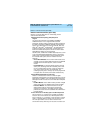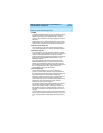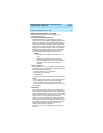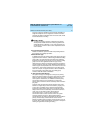
MERLIN LEGEND Communications System Release 7.0
Pocket Reference
555-670-116
Issue 1
April 1999
9
Release 6.0 Enhancements (February 1998)
Although many features are available using tie trunks for
network connectivity, PRI tandem trunks provide greatly
enhanced features and faster call setup. For this reason, PRI is
recommended over tie functionality in private networks.
■ Group Calling Enhancements
Release 6.0 and later systems include Group Calling features
that enhance group calling operations.
■ Queue Control
The system manager can control the maximum number of calls
allowed in the primary calling group queue for calls that arrive
on certain facilities often assigned to calling groups. When the
number of the calls in queue reaches the programmed
maximum, subsequent callers receive a busy signal.
Queue control applies to calls received on the following types of
facilities:
— Direct Inward Dialing (DID)
— PRI facilities programmed for dial-plan routing
— All calls transferred from a voice messaging interface (VMI)
port
— Dial-in Tie
Queue control also applies to internal calls to a calling group
and calls to a calling group through the Queued Call Console
(QCC).
Internal calls that dial #0 or #800 and are directed to a calling
group administered as Position-Busy Backup are eligible for
queue control. Calls that come in on a trunk assigned to the
QCC are not eligible for queue control if the call is directed to a
calling group designated as Position-Busy Backup.
Remote-access calls to a calling group, coverage calls directed
to a calling group, calls directed to a calling group through QCC
Position-Busy Backup, and all other outside calls are not eligible
for queue control.
■ Prompt-Based Overflow
System managers can activate the Prompt-Based Overflow
option. This option allows callers waiting in queue and listening
to a delay announcement to press the # key in order to reach
the overflow receiver for the group, which may be the QCC
queue or another calling group (including a calling group
assigned for a voice mail system).
All three overflow distribution options—based on the number of
calls, the time a caller has waited, and according to the caller’s
prompt—may be used at one time. In this case, time-based and
number-of-calls based options take precedence over overflow
distribution based on the caller’s prompt.
When prompt-based overflow distribution is used, an extra TTR
must be provided for each delay announcement device
assigned to the associated calling group. The delay
announcement informs the caller of the # key option to exit the
queue and leave rather than waiting for an agent. If no TTR is
available when a calling group call arrives, the call is not sent to
a delay announcement extension.


















